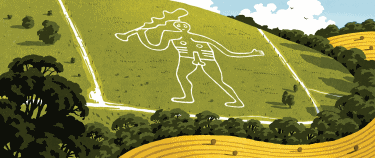Generations have speculated about the age and meaning of the club-brandishing giant hewn into a Dorset hillside. Was he a depiction of the legendary demi-god Hercules, an ancient fertility symbol, or even the soldier and statesman Oliver Cromwell? Another theory holds that the figure was carved around the body of a giant who was slain by local people after he terrorised the countryside.
Now, after state-of-the art sediment analysis jointly funded by the National Trust, the University of Gloucestershire, Allen Environmental Archaeology and the Pratt Bequest, National Trust archaeologists have concluded the giant was probably first constructed in the late Saxon period.
Independent geoarchaeologist Mike Allen, whose research is helping the Trust understand more about the landscape in which the giant was created, said the result was surprising.
‘This is not what was expected. Many archaeologists and historians thought he was prehistoric or post-medieval, but not medieval. Everyone was wrong, and that makes these results even more exciting.’
Phillip Toms, Professor in Physical Geography at the University of Gloucestershire, studied the samples using Optically Stimulated Luminescence (OSL), which shows when individual grains of sand in the sediment were last exposed to sunlight. Material taken from the deepest layer (1m) yielded a date range of 700-1100AD which suggests the giant was first made by late Saxons.
National Trust senior archaeologist Martin Papworth said: “The archaeology on the hillside was surprisingly deep – people have been re-chalking the giant over a long period of time. The deepest sample from his elbows and feet tells us he could not have been made before 700AD, ruling out theories that he is of prehistoric or Roman origin.
‘This probable Saxon date places him in a dramatic part of Cerne history. Nearby Cerne Abbey was founded in 987AD and some sources think the abbey was set up to convert the locals from the worship of an early Anglo Saxon god known as ‘Heil’ or ‘Helith’. The early part of our date range does invite the question, was the giant originally a depiction of that god?’
But other samples – taken with permission from Historic England and the Secretary of State – gave later dates of up to 1560, which presented Martin and his team with a conundrum, because the earliest documented record of the giant is a church warden’s account of repairing him in 1694.
‘The science suggests he could be medieval, but intriguingly, surviving documents from Cerne Abbey don’t mention the giant. In the 16th century it’s as if the giant’s not there, and John Norden’s survey of 1617 makes no mention of him. And why would a rich and famous abbey – just a few yards away – commission, or sanction, a naked man carved in chalk on the hillside?’
Martin’s working theory is that the giant may have been a medieval creation but then – for reasons we may never know – was neglected for several hundred years, before being rediscovered.
‘I wonder whether he was created very early on, perhaps in the late Saxon period, but then became grassed over and was forgotten. But at some stage, in low sunlight, people saw that figure on the hill and decided to re-cut him again. That would explain why he doesn’t appear in the abbey records or in Tudor surveys.’





